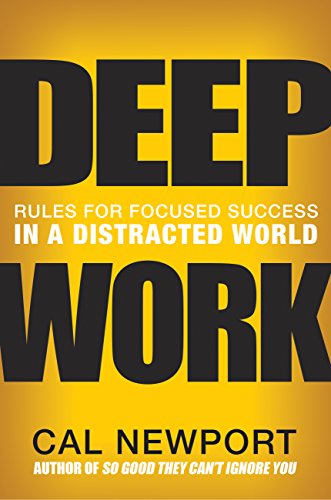Blog Short #86: My Summer Reading List to Up Your Productivity

Photo by baona, Courtesy of iStock Photo
Summer’s here! And that reminds me of summer reading assignments from school. Most kids hate them because, well, who wants to have homework during the summer? Probably no one, but I haven’t lost the summer reading habit. And when it’s voluntary, it’s not a problem.
Summer’s a good time to take stock of what I call “personal operations.” In other words, how’s your productivity and focus? Are you sticking to good habits and finishing things you start?
If not, this reading list will give you what you need to make changes that stick. I’ve got six titles in all, but I’ll admit I had a hard time limiting my list to just six. I’ve added some others at the end of the blog you can check out if you like.
My first book is all about habits.
1. Atomic Habits by James Clear
 Atomic Habits is one of the most valuable books I’ve ever read, and I return to it often to remind myself of the steps that lead to creating and instilling new habits permanently. Clear begins with three ideas that run throughout the book:
Atomic Habits is one of the most valuable books I’ve ever read, and I return to it often to remind myself of the steps that lead to creating and instilling new habits permanently. Clear begins with three ideas that run throughout the book:
1) Habits have compounding effects meaning they increase in power over time. These effects apply to negative patterns as well as positive ones.
2) The point of focus needs to be on process rather than outcomes. By building a system of incremental improvements daily, we reach goals.
3) Habits that stick become part of our identity.
He goes on to offer Four Laws to implement building new habits, and he details the specific actions to make that work and overcome obstacles that get in the way. It reads like a handbook for habit-building. And what a great handbook!
2. Finish by Jon Acuff
 I’m great at starting but not so great at finishing. If that rings a bell for you, you’ll love this book!
I’m great at starting but not so great at finishing. If that rings a bell for you, you’ll love this book!
Jon Acuff has a good grasp of the emotional issues that get in the way of finishing things you start, and he outlines all of them in detail. He hits especially hard on perfectionism and does it in a way that even a perfectionist can accept.
The book is full of strategies that are easy to use to keep you under the radar of your resistance. His approach is both powerful and useful. A big plus is that he writes with a lot of humor and is easy to read, so much so that you’ll want to finish this book!
3. Essentialism by Greg McKeown
 There are some books everyone should read, and this one falls into that category. Greg McKeown presents a complete system and methodology for cleaning out life’s input and narrowing your focus down to what’s essential. He’s the Marie Kondo for decluttering your emotional home.
There are some books everyone should read, and this one falls into that category. Greg McKeown presents a complete system and methodology for cleaning out life’s input and narrowing your focus down to what’s essential. He’s the Marie Kondo for decluttering your emotional home.
He divides the book into four sections: Essence, Explore, Eliminate and Execute. Under each, McKeown offers practical approaches and methods for successfully applying the main concepts. One of my favorites is the 90 Percent Rule. In his words:
“As you evaluate an option think about the single most important criterion for that decision, and then simply give the option a score between 0 and 100. If you rate it any lower than 90 percent, then automatically change the rating to 0 and simply reject it.”
His system is thoughtful, proactive, and easy to follow. Most of all, it’s an antidote to the overwhelm resulting from too much coming in from all sides. He shows you how to take charge of that and simplify. A must-read.
4. Deep Work by Cal Newport
 Deep Work is the book to read if you have work that requires intensive brain power and concentration. Newport starts by making a distinction between “deep work” and “shallow work.”
Deep Work is the book to read if you have work that requires intensive brain power and concentration. Newport starts by making a distinction between “deep work” and “shallow work.”
Deep work is cognitively demanding and pushes your cognitive capabilities to their limit, whereas shallow work includes tasks you can perform while dealing with distractions. Think writing a paper versus catching up on emails.
From there, the book offers strategies for setting up an environment and system for engaging in deep work in time blocks when you’re most likely to be able to attend, focus and persevere. Newport’s methods work!
I use them regularly and have seen significant improvement in my output. I especially like scheduling your “deep work” time blocks first and then fitting in shallow work around those. The separation of the two is relieving and frees your mind to concentrate with greater success.
5. The War of Art by Steven Pressfield
 These last two books on my list deal with resistance. The War of Art is one of those must-read books on the list for anyone who is or has tried to pursue a goal requiring sustained, engaged, creative effort.
These last two books on my list deal with resistance. The War of Art is one of those must-read books on the list for anyone who is or has tried to pursue a goal requiring sustained, engaged, creative effort.
His premise is that as soon as you decide to pursue a goal like creating a company, writing a book, learning to play an instrument, sticking to a diet, or anything that requires staying power, you’re met with both internal and external resistance that hammers at you throughout the process. It’s inevitable and happens to everyone.
He shows you all the ways this happens, many of which sneak in under your awareness radar, and then he tells you how to outsmart them. If there’s anything you want to accomplish, read this book first! It’s a brilliant book and hits you right between the eyes.
6. Grit by Angela Duckworth
 Grit’s been on the New York Times bestseller list forever, and that’s because it’s a textbook for finding and growing passion for work through perseverance and commitment. Duckworth makes an important distinction between talent and grit and focuses on grit as the most necessary ingredient for success in any endeavor.
Grit’s been on the New York Times bestseller list forever, and that’s because it’s a textbook for finding and growing passion for work through perseverance and commitment. Duckworth makes an important distinction between talent and grit and focuses on grit as the most necessary ingredient for success in any endeavor.
The book is comprehensive in its inclusion of work done by other researchers and authors including deliberate practice, the experience of “flow,” the growth mindset, and peak performance. Duckworth’s research is stellar, and she uses real-life examples throughout the book to illuminate the material.
“Grit” is the thing that gets us through failures, setbacks, and obstacles. Developing and sustaining it is crucial, and this book provides the steps to do that.
Other Books You Might Like
If you read a couple of books from the list above, you’ll benefit greatly and learn how to create a system that’ll work. However, here are a few other titles you might like.
Focus: The Hidden Driver of Excellence by Daniel Goleman
Effortless: Make It Easier to Do What Matters Most by Greg McKeown
The Power of Habit by Charles Duhigg
Mindset: The New Psychology of Success by Carol Dweck
Flow: A Psychology of Optimal Experience by Mihaly Csikszentmihalyi
The Practicing Mind by Thomas M. Sterner
Do the Work by Steven Pressfield (a short version of The War of Art)
All these books are worth reading, and you can read any of them leisurely over time. It depends on how you like to read nonfiction books, how dense the material is, and whether the subject matter targets your interest and needs.
I do know that reading any one of them will give you something you can use and raise your level of productivity and work satisfaction, regardless of what work you’re pursuing.
Happy reading!
I’ll see you next week!
All my best,
Barbara








